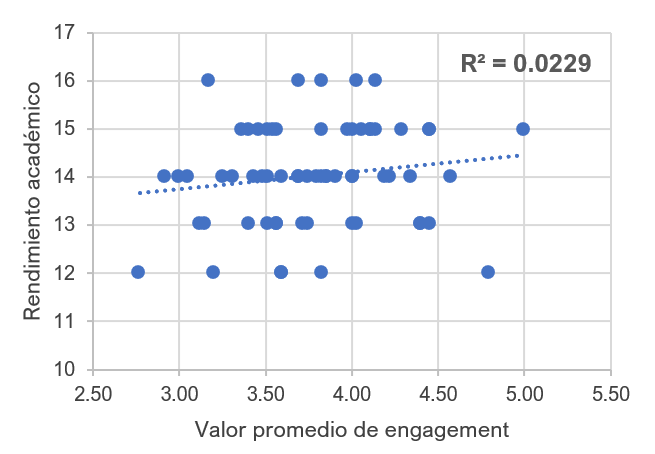Engagement y rendimiento académico en estudiantes universitarios: Experiencia en una asignatura de gestión en salud
Resumen
Objetivo: Analizar el engagement y rendimiento académico en estudiantes universitarios del curso Gestión en Salud durante el año 2023. Material y métodos: Investigación de diseño no experimental tipo correlacional, la población de estudio estuvo conformada por estudiantes de la Escuela Profesional de Obstetricia matriculados en el curso Gestión en Salud. El tipo de muestreo utilizado fue no probabilístico intencional. La recolección de datos se realizó mediante el cuestionario denominado “Student Engagement Questionnaire”, contiene 35 preguntas distribuidas en cinco dimensiones, con respuestas mediante una escala de Likert; tiene un coeficiente de fiabilidad entre 0,70 y 0,93. El rendimiento académico fue medido mediante el promedio final de notas según escala vigesimal. El procesamiento de datos se realizó mediante SPSS versión 22 y la prueba de Rho de Spearman. Resultados: La muestra final estuvo conformada por 64 estudiantes, edad promedio 22,7 años. La oportunidad de participar en clase obtuvo un valor promedio 4,22. Sentirse capaz de aportar información y diferentes ideas para resolver problemas un valor 4,03 y la ayuda de profesor para responder preguntas fue 4,08. La dimensión relaciones profesor-estudiantes y docencia presentaron un valor promedio 3,85 y 3,6 respectivamente. Con respecto al rendimiento académico: 35,94% tuvo un rendimiento de 14. El coeficiente de determinación entre engagement y rendimiento académico no presentó relación significativa (p=0,02). Conclusión: Los estudiantes tienen mejor compromiso en las dimensiones trabajo en equipo y la relación profesor-estudiantes. El engagement no influye en el rendimiento académico de los estudiantes.
Citas
Sánchez-Sánchez J, Alarcón-Loayza J, Villa-Castillo L, Kohli M, Boehme CC, Carmona S, et al. Availability of essential diagnostics at primary care public clinics in Peru. Microbes Infect. 2021 Jan-Feb; 23(1): 104761. DOI: https://doi.org/10.1016/j.micinf.2020.09.007.
Carrasco-Escobar G, Manrique E, Tello-Lizarraga K, Miranda JJ. Travel time to health facilities as a marker of geographical accessibility across heterogeneous land coverage in Peru. Front Public Health. 2020 Sep; 8: 498. DOI: https://doi.org/10.3389/fpubh.2020.00498.
Rahemi Z, DʼAvolio D, Dunphy LM, Rivera A. Shifting management in healthcare: An integrative review of design thinking. Nurs Manage. 2018 Dec; 49(12): 30-7. DOI: https://doi.org/10.1097/01.numa.0000547834.95083.e9.
Martinez JC, King MP, Cauchi R. Improving the health care system: Seven state strategies. National Conference of State Legislatures. Washington: NCSL; 2016.
Matzumura-Kasano JP, Gutiérrez-Crespo H, Pastor-García C, Ruiz-Arias RA. Valoración del trabajo colaborativo y rendimiento académico en el proceso de enseñanza de un curso de investigación en estudiantes de medicina. An Fac Med. 2019; 80(4): 457-64. DOI: http://dx.doi.org/10.15381/anales.v80i4.17251.
Matzumura Kasano JP, Gutiérrez-Crespo H, Pastor-García C, Zamudio-Eslava LA, Ruiz-Arias RA. Metodología activa y estilos de aprendizaje en el proceso de enseñanza en el curso de metodología de la investigación de una facultad de ciencias de la salud. An Fac Med. 2018; 79(4): 293-300. DOI: http://dx.doi.org/10.15381/anales.v79i4.15632.
Sakiz H, Ekinci A, Sarıçam H. Teachers’ perceptions of their school managers’ skills and their own self-efficacy levels, Int J Leadersh Educ. 2020; 23(5): 585-603. DOI: https://doi.org/10.1080/13603124.2018.1562094.
Saha GG. Student engagement: A strategic tool. The Standard International Journals. 2014; 2(3):153-7.
Jang H, Kim, EJ, Reeve J. Longitudinal test of self-determination theory’s motivation mediation model in a naturally occurring classroom context. J Educ Psychol. 2012; 104(4): 1175-88. DOI: https://psycnet.apa.org/doi/10.1037/a0028089.
Ergin DY. Developing the scale of classroom management skills. J Educ Train Stud. 2019; 7(4): 250-58. DOI: https://doi.org/10.11114/jets.v7i4.4024.
Axelson RD, Arend F. Defining student engagement. Change: The Magazine of Higher Learning. 2010; 43(1): 38-43. DOI: https://doi.org/10.1080/00091383.2011.533096.
Groccia JE. What is student engagement? New Dir Teach Learn. 2018; 154: 11-20. DOI: https://doi.org/10.1002/tl.20287.
Fredricks JA, Wang MT, Linn JS, Hofkens TL, Sung H, Parr A, et al. Using qualitative methods to develop a survey measure of math and science engagement. Learn Instr. 2016; 43(1): 5-15. DOI: https://doi.org/10.1016/j.learninstruc.2016.01.009.
Cevikbas M, Kaiser G. Student engagement in a flipped secondary mathematics classroom. Int J Sci Math Educ. 2022; 20(7): 1455-80. DOI: https://doi.org/10.1007/s10763-021-10213-x.
Gargallo B, Suárez-Rodríguez JM, Almerich G, Verde I, Cebrià MA. The dimensional validation of the Student Engagement Questionnaire (SEQ) with a Spanish university population. Students’ capabilities and the teaching-learning environment. Anal Psicol. 2018; 34(3): 519-30. DOI: https://dx.doi.org/10.6018/analesps.34.3.299041.
Padgett J, Cristancho S, Lingard L, Cherry R, Haji F. Engagement: what is it good for? The role of learner engagement in healthcare simulation contexts. Adv Health Sci Educ Theory Pract. 2019 Oct; 24(4): 811-25. DOI: https://doi.org/10.1007/s10459-018-9865-7.
Gresalfi M, Barab S. Learning for a reason: Supporting forms of engagement by designing tasks and orchestrating environments. Theory Pract. 2011; 50(4): 300-10. DOI: https://doi.org/10.1080/00405841.2011.607391.
Duke B, Harper G, Johnston M. Exploring spaces for learning: connectivism as a digital age learning theory. The International HETL Review. 2013: 4-13.
O’Connor S, Jolliffe S, Stanmore E, Renwick L, Booth. Social media in nursing and midwifery education: a mixed study systematic review. J. Adv. Nurs. 2018 Oct; 74(10): 2273-89. DOI: https://doi.org/10.1111/jan.13799.
Lee H, Min H, Oh SM, Shim K. Mobile technology in undergraduate nursing education: a systematic review. Healthc Inform Res. 2018 Apr; 24(2): 97-108. DOI: https://doi.org/10.4258%2Fhir.2018.24.2.97.
Waltz CF, Jenkins LS, Han N. The use and effectiveness of active learning methods in nursing and health professions education: a literature review. Nurs Educ Perspect. 2014 Nov; 35(6): 392-400. DOI: http://dx.doi.org/10.5480/13-1168.
Whitelock-Wainwright A, Laan N, Wen D, Gašević, D. Exploring student information problem solving behaviour using fine-grained concept map and search tool data. Comput Educ. 2020; 145: 103731. DOI: https://doi.org/10.1016/j.compedu.2019.103731.
Matzumura-Kasano JP, Gutiérrez-Crespo H, Zamudio-Eslava LA, Zavala-Gonzales JC. Aprendizaje invertido para la mejora y logro de metas de aprendizaje en el Curso de Metodología de la Investigación en estudiantes de universidad. Educare. 2018; 22(3): 177-97. DOI: http://dx.doi.org/10.15359/ree.22-3.9.
Oyler DR, Romanelli F, Piascik P, Cain J. Practical insights for the pharmacist educator on student engagement. Am J Pharm Educ. 2016 Oct; 80(8): 143. DOI: https://doi.org/10.5688%2Fajpe808143.
Ghasemi MR, Moonaghi HK, Heydari A. Strategies for sustaining and enhancing nursing students’ engagement in academic and clinical settings: a narrative review. Korean J Med Educ. 2020 May; 32(2):103-17. doi: https://doi.org/10.3946%2Fkjme.2020.159.
Ghasemi MR, Moonaghi HK, Heydari A. Student-related factors affecting academic engagement: a qualitative study exploring the experiences of Iranian undergraduate nursing students. Electron Physician. 2018 Jul; 10(7): 7078-85. DOI: https://doi.org/10.19082%2F7078












